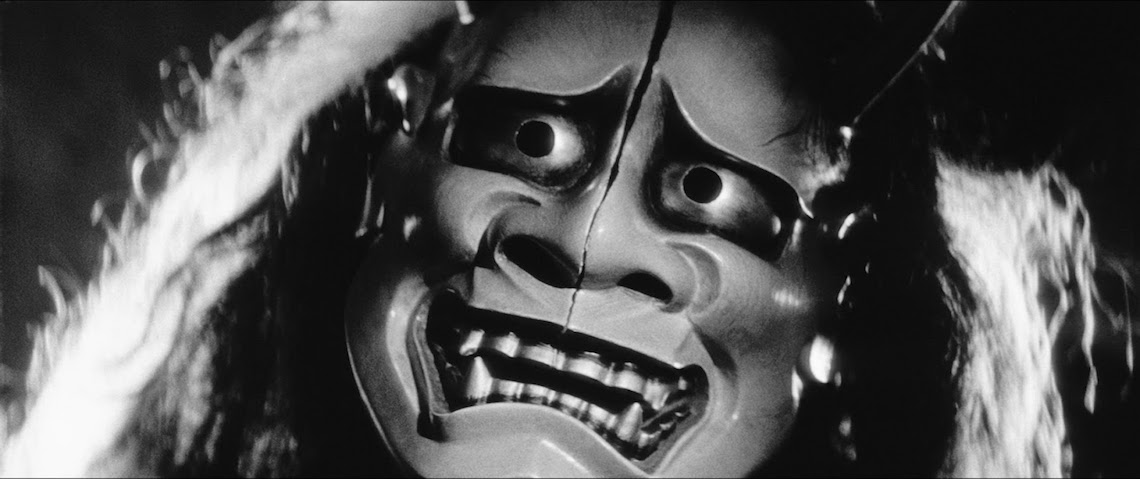“I am not a demon! I am a human being!”, yells the woman known only as Kichi’s Mother. This is the declaration made by the protagonist of Kaneto Shindô’s most celebrated work, Onibaba, as she maniacally claws at the uncanny mask which has gripped itself to her face. The mask is a Noh Mask, noh translating roughly as talent or skill in artistic performance. There are around 450 variations of the mask, taken from 60 broader types. The mask, in the dramatic milieu, indicates the character’s age, gender, ranking or nonhuman form and allows the performer to appear as such. Here, the mask is a demonic one, specifically a Hannya mask, used to indicate a jealous female demon. Its wearer here immediately admits to its facade, assuring Kichi’s Mother that he is not a demon, using the mask instead to protect his beautiful human form underneath. The mask seems to have a life of its own: its appearance is uncannily expressive and it seems to choose its own host, regardless of whether said host desires it or not.
The film is as rich in tradition as it is in atmosphere, making for a primordial morality tale, based on a Buddhist fable and saturated in lust and paranoia. Broadly, it tells the story of a Kichi’s Mother and Kichi’s Wife, who support themselves in an environment of perpetual war a destruction by trapping and killing passing Samurais, then trading their wares for food and provisions. Once the two women’s neighbour Hachi returns, notably without Kichi, Kichi’s Wife embarks on a passionate and emotionally intense affair with Hachi. Kichi’s Mother fears that this will drive her daughter-in-law away, which would prove ruinous to her continued work and survival. Kichi’s Mother attempts to drive a wedge between the two by any means possible before being confronted by the aforementioned masked Samurai who, lost in the long reeds, insists that she guide his way to the nearby swamps. Kichi’s Mother leads the Samurai to the chasm in which she dumps her victims, killing the man before retrieving his possessions and, with great difficulty, his mask, which, contrary to what the man has told her, hides a horribly disfigured form underneath. Kichi’s Mother continues her pursuit to break up the star-crossed lovers, building to a truly terrifying and symbolically-rich finale.
Shindô described his film as one concerning the “sexual desire of the soul” and, certainly, it is erotically- and morally-charged therein. Erotics and morals may seem like antonyms of each other and, indeed, that is what many of us have been taught: lust is vice, morals are virtues and one must give way to the other. Shindô disrupts this concept and was incredibly ahead of his time because of it. In the main, he makes the antithetical complimentary: his frames, for example, are awash with darkness and shadows however this only serves to enhance the sublime beauty within them, rather than masking it. His use of extreme close-up is masterful, reducing an already unremarkable story to its component parts: blades of grass; beads of sweat; robes falling loosely on shoulders. Unremarkable, it must be added, is not being used as a denunciation of the film’s quality. Rather, it is yet another way in which Shindô makes the antithetical complimentary. The broad themes of jealousy, lust, power and violence are well-trodden in the habitat of the morality fable and here Shindô uses story as a dressing for his setting as opposed to the established alternative. The whole film, essentially, rewrites the morality tale as a visual art, using a claustrophobic and imposing sense of dread to make themes into atmosphere, causing the film to have an almost somatic effect on its viewer.
It’s all rather hard to explain and warrants experiencing for oneself but, in any case, it’s a masterclass in atmosphere, dread and claustrophobia from one of the most prolific and consistent voices in Japanese cinema. With 216 writing credits and 46 directing credits to his name, it can be hard to know where to begin with Shindô. However, if you take the time, you will find a thoroughly intelligent and even prophetic cinematic virtuoso therein. Onibaba, represents a perfect, 100-minute distillation of his talent and inimitable voice and insists to be watched, re-watched and endlessly pondered.
‘Where to Begin: Kaneto Shindô and Onibaba’ is an article written by Matthew Rooney.

